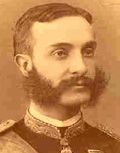Born within the marriage of Queen Isabel II and Francisco de Asís María Fernando de Borbón y de Borbón-Dos Sicilias, though his biological paternity was questioned as his father was believed to have been homosexual; moved to France with his family after the Revolution of 1868; received education at the Theresianum, a college for young nobles in Vienna, Austria-Hungary (1870-1873); proclaimed king in exile when his mother abdicated in his favor in Paris (25 Jun 1870), but he continued to use the style Príncipe de Asturias; was enrolled in the Royal Military College, Sandhurst, England (1873-1874); issued a manifiesto (1 Dec 1874), drafted by Antonio Cánovas del Castillo, outlining how he would reign; was proclaimed as King of Spain (29 Dec 1874) by General Arsenio Martínez Campos y Antón in charge of the troops at Sagunto, Valencia; the proclamation was supported by the army and politicians in Madrid, and culminated in creation of the Ministerio-Regencia (Ministry-Regency) chaired by Cánovas (31 Dec 1874); returned to Spain on 9 Jan 1875 and made his entry into Madrid on 14 Jan 1875; participated in the battles of the Third Carlist War (1872-1876); enacted the Constitution of 1876, which laid foundations for constitutional monarchy in Spain; survived two attempts of assassination (1878, 1879); after premature death of his first wife, he married María Cristina of Austria (29 Nov 1879); ruled under strong influence of Cánovas, whose conservatism cost some popularity of the young king; died of tuberculosis in the age of twenty-eight. Biography source: [6] |

